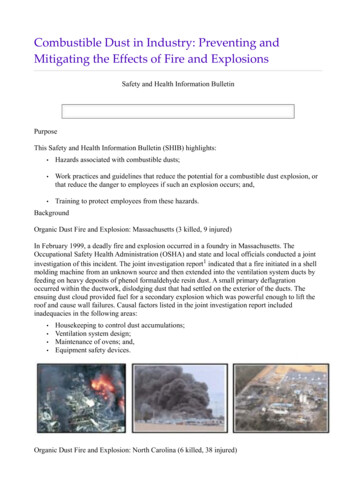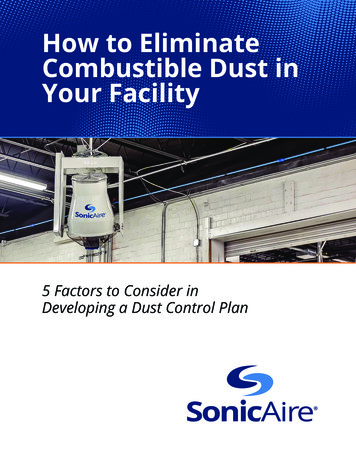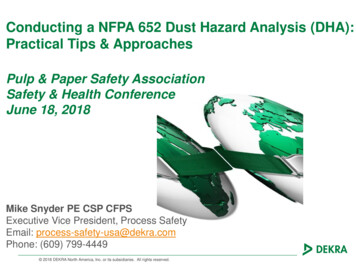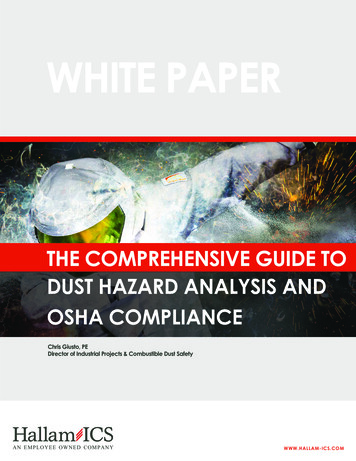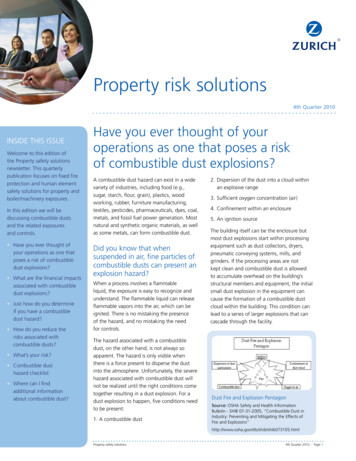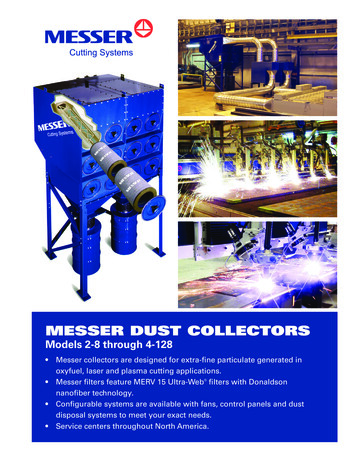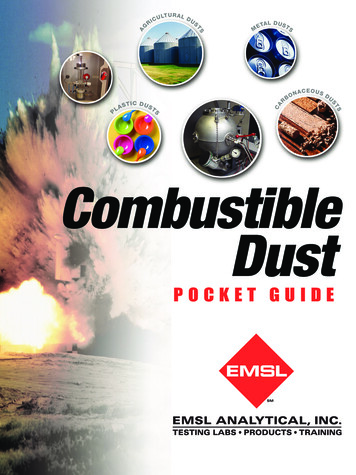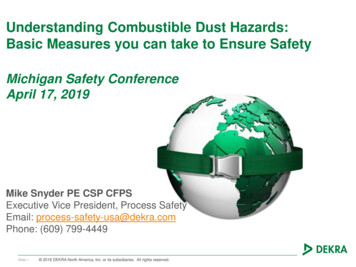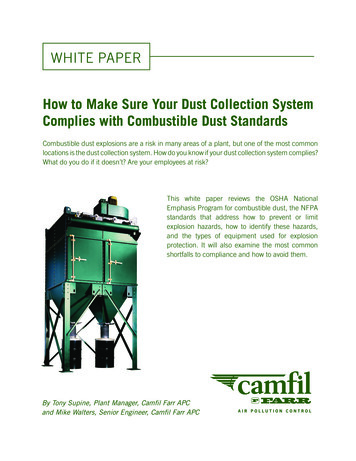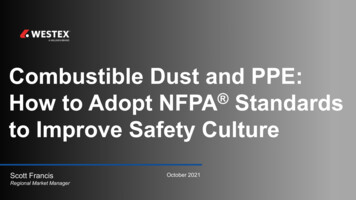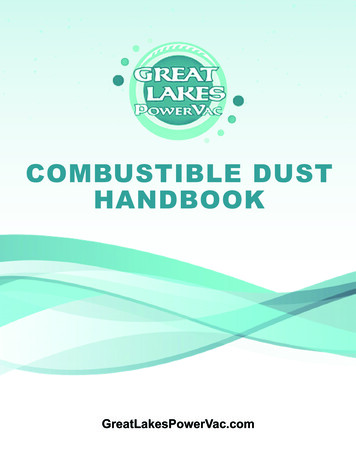
Transcription
COMBUSTIBLE DUSTHANDBOOKGreatLakesPowerVac.com
TABLE OF CONTENTSINTRODUCTION . . . . . . . . . . . . . . . . . . . . . . . . . . . . . . . . . . . . . 3ARE ALL TYPES OF DUST COMBUSTIBLE? . . . . . . . . . . . 4DO I HAVE A COMBUSTIBLE DUST SITUATION? . . . . . . 8HOW DO I REMOVE COMBUSTIBLE DUST? . . . . . . . . . . 13THE RIGHT EQUIPMENT FORCOMBUSTIBLE DUST REMOVAL . . . . . . . . . . . . . . . . . . . . 17MONITORING DUST AFTER CLEANING . . . . . . . . . . . . . . 22HOW COMBUSTIBLE DUST PREVENTIVEMAINTENANCE SAVES MONEY & REDUCES RISK . . . 27CONTACT US . . . . . . . . . . . . . . . . . . . . . . . . . . . . . . . . . . . . . . 32BEFOREGreatLakesPowerVac.comAFTER2
INTRODUCTIONThank you for downloading this E-book. It is the result of extensive research,writing and editing — tapping into the collective expertise of not only GreatLakes Power Vac professionals, but also some of the dust mitigationindustry’s most respected thought leaders.Dust accumulation in an industrial facility is a serious risk. The biggest risk,obviously, is to the safety and wellbeing of your employees. A dust fire orexplosion can have devastating consequences. Secondarily, excessive dustaccumulation can impact the financial health of an organization in many ways,from regulatory fines and stop-work orders, to product quality issues, andreductions in productivity and employee retention.Safeguarding against these risks is entirely possible but requires commitment.Planning and prevention go a long way. A reliable dust mitigation programincludes effective and well-maintained dust collection equipment, regularlyscheduled cleaning, and ongoing monitoring. An effective program engageseveryone working in the facility; because, combustible dust is everyone’sproblem.That said, it is important to recognize that removing combustible dustfrom an industrial facility is not as simple as grabbing a broom or genericshop vacuum. In fact, a facility’s risk level can increase when the wrongcleaning methods or equipment are used. The safe and efficient removalof combustible dust requires specialized training and equipment that not allindustrial cleaning companies can provide.While combustible dust mitigation is everyone’s problem, the commitmentmust start at the top with company leadership. Investing in the right dustcollection equipment is the first step. Developing internal processes andpolicies with respect to dust monitoring and cleaning is another importantaction to take. Hiring a reputable cleaning contractor with specialization incombustible dust removal is also essential.Make no mistake, combustible dust presents serious risks to a wide range ofindustrial facilities. But when armed with the right knowledge, resources andpartners, those risks can be managed. We trust that the information providedin this E-book will help you develop an effective management plan ofyour own.GreatLakesPowerVac.com3
ARE ALL TYPES OF DUSTCOMBUSTIBLE?Dust can pose a serious fire risk in a variety ofindustrial facilities. It’s important for businesses tounderstand the types of dust they may encounter,along with the factors that create a potentiallycombustible situation.There are two broad categories of industrial dust.The first relates to dust that is a direct product ofprocessing operations, such as in pharmaceuticalor cereal manufacturing. “You normally wouldn’tDr. Chris Cloneyeven call this dust; you would refer to this aspowder,” says Dr. Chris Cloney, Managing Director and Lead Researcher forDustEx Research, a company with worldwide focus on increasing awarenessof combustible dust hazards.The second type of dust is a byproduct of the material being processed.“As you dump, convey or process the material, it often breaks down andleaves a dust-like substance,” Cloney says. This substance accumulates inand around the equipment before eventually spreading further into the facility.If left unattended, this type of dust creates significant risk for a facility.WHAT MAKES DUST COMBUSTIBLE?The National Fire Protection Association (NFPA) once said that in order to becombustible, dust had to be of a specific particle size: 420 microns or smaller,which is smaller than half a millimeter. That seemed to make a lot of sense.Think about firewood, for instance. A log will burn but kindling burns a lotfaster. The smaller the kindling, the faster it burns.Nowadays, however, the NFPA doesn’t specify particle size. “Any particulatematter that provides a deflagration hazard is deemed combustible,” Cloneypoints out. “This new definition has been picked up by both OSHA and theCanadian Center for Occupational Health & Safety.”GreatLakesPowerVac.com4
WHAT MAKES DUST COMBUSTIBLE?The fifth element of the Dust Explosion Pentagon is confinement. When aflash fire breaks out and is contained in a confined area, pressure can buildup to the point that an explosion occurs. “Think of confined spaces such ashoppers, dust collectors and silos,” Cloney says.THE CONSEQUENCES OF NON-COMPLIANCENFPA 652 is not a regulation. But that doesn’tmean businesses can ignore the dust hazards intheir facilities.OSHA has a general-duty clause saying thatemployers are required to have a workplace safefrom known hazards. Because NFPA has publisheda considerable amount of information related tocombustible dust, combustible dust is a known hazard.“OSHA will often cite its general-duty clause whenworkplaces are not in compliance with theNFPA guidelines,” Cloney points out.OSHA also has its Hazard Communication Standard (HCS) which outlines anemployer’s responsibility to communicate hazards to workers. “There are alsoindustry-specific guidelines OSHA has developed, such as its grain-handlingstandard,” Cloney says.Another level of regulation ties to state and local jurisdictions. A state canchoose to adopt OSHA’s federal regulations, adopt a state-level OSHAregulation, or develop its own regulation, perhaps through local fire orbuilding codes.Regardless, businesses need to know the laws they need to comply with.Failure to comply could lead to the following: Fines Stop work orders Inability to obtain insuranceGreatLakesPowerVac.com5
In the event of a combustible dust fire or explosion, a business could also beexposed to various lawsuits. For example, Cloney points to a grain elevatorexplosion in Nebraska. The city’s disaster response efforts resulted in tens ofthousands of dollars in expenses. The city ended up suing the elevator ownerfor financial reimbursement.OVER 300 CATASTROPHICINCIDENTS IN NORTH AMERICALAST YEAR ALONEAside from the financial repercussions of non-compliance, Cloney saysbusinesses should first think about the human component. “What are theramifications of not following the NFPA’s guidance in the first place?” Cloneyasks. The result could be something as catastrophic as an explosion thatdecimates an entire facility, as was the case with a sugar refinery in PortWentworth, Georgia. More importantly, 14 people were killed and another38 injured.Horrific events such as that happen regularly. Cloney assembles an annual“Combustible Dust Incident Report”. There were over 300 catastrophicincidents in North America last year. That’s roughly six per week. Of those300 incidents, 32 included an explosion. You can download these reports atCloney’s website, DustEx Research - Incident Database.“We have several clients in the foundry industry,specifically those dealing with aluminum andgray iron where the dust created is highly reactive.”- Dan Bemi, General Manager forGreat Lakes Power VacCombustible dust hazards can affect numerous types of industrial facilities.Great Lakes Power Vac assists in dust mitigation in a number of thosesettings. “We have several clients in the foundry industry, specifically thosedealing with aluminum and gray iron where the dust created is highly reactive,”says Dan Bemi, General Manager for Great Lakes Power Vac, a Wisconsin-GreatLakesPowerVac.com6
based provider of industrial cleaning and environmental services since 2004.“We also work in the grain handling industries where clients are dealing with alot of organic product and have containment structures such as silos. We alsohave clients in food, plastics and chemical manufacturing, as well as powergeneration companies and fabricators.”In all of these industries, and many more, a variety of industrial dust iscreated. Not all of that dust is necessarily combustible, but there’s a goodchance that it is. Waiting for a fire or explosion to happen is not the best wayto find out. Businesses should heed the guidelines offered by the NFPA andbegin assessing the combustible dust hazards in their facilities — before it’stoo late.GreatLakesPowerVac.com7
DO I HAVE ACOMBUSTIBLEDUST SITUATION?According to the NFPA (National Fire Protection Association), any dust thatposes a deflagration hazard, regardless of particulate size or shape,is considered combustible.Referencing NFPA standards, OSHA has identified three types of facilitiesthat are deemed hazardous due to the presence of combustible dust inthe atmosphere: Metal dusts such as aluminum, magnesium and other commercial alloys Carbonaceous dusts that have more than 8% total entrapped volatiles,or have been sensitized by other materials so they present anexplosion hazard Dusts emanating from flour, grain, wood, plastic and chemicalsThe following list of specific products helps illustrate the wide variety ofindustrial facilities that could have the potential of a combustible dust fireor explosion: Powdered milk Sugar Coffee Corn meal Rice Tea Coal Pine soot Sulfur Aluminum Epoxy resinBEFOREAFTEROSHA provides an extensive list of products and materials that present acombustible dust explosion risk. Download OSHA Poster.GreatLakesPowerVac.com8
TESTING FOR DUST COMBUSTIBILITYIf you operate a facility that fits any of the above descriptions, it is time tobegin taking the potential of combustible dust seriously. However, the onlyway to definitively conclude that a dust is combustible is to have it tested ina laboratory.“If the dust burns exothermically, it has the potential to be a combustible dust,”says Dr. Chris Cloney.“If the dust burns exothermically,it has the potential to be a combustible dust.”- Dr. Chris Cloney, Managing Directorand Lead Researcher for DustEx ResearchThe next question is whether or not the dust can burn fast enough to cause aflash fire or explosion. “I recommend putting the dust through the NFPA’sgo/no-go test to see if it burns,” Cloney says.Laboratory analysis is a particularly useful step for one simple reason:Dust you might not think is combustible could be, and conversely, dust youthink is combustible might not be.“We recently had a client in the tobacco industry,”says Ashok Dastidar, Vice President of Dust andFlammability Testing and Consulting Servicesat Fauske & Associates, an Illinois-based worldleader in nuclear, industrial and chemical processsafety. “NFPA standards suggest that tobaccohas certain combustible properties. The clientsent us a sample. It was a very fine dust. Wetested it and it didn’t explode. If the client hadassumed their dust was combustible, they mayhave been overly conservative in implementingan abatement plan.”Ashok DastidarAccording to Dastidar, the process of having a dust sample tested is relativelystraightforward and inexpensive. Download How to Speak CombustibleDust Testing.GreatLakesPowerVac.com9
“The cost of having a test done is insignificant compared to the cost ofinstalling all kinds of unnecessary protection equipment,” Dastidar points out.“Even if you look at that list of products from OSHA and assume your dustis combustible, it’s still important to have your dust tested to determine howenergetic and sensitive the material is.”“The cost of having a test done is insignificantcompared to the cost of installing all kinds ofunnecessary protection equipment.”- Ashok Dastidar, Vice President of Dust andFlammability Testing and Consulting Servicesat Fauske & AssociatesDastidar says facilities should take dustsamples from various locations: Dust collection equipment,i.e. cartridge filters Overhead bins Horizontal ledges Floor“We recommend that material of 500 microns or smaller be tested to see if itwill explode,” Dastidar says. (That’s a particle size of about half a millimeter.)Dust that comes back as non-explosible can typically be deemed lowerpriority and revisited later on, perhaps at an even finer dust fraction to see if asmaller particle size creates an issue.“Dust that comes back from testing as explosible requires further testing,”Dastidar adds. “It’s much like going to the doctor for your annual checkup.You get your bloodwork done and then have your consultation. With dusttesting, that first round of screening tells you there is a problem. But then youneed data to solve the problem.”For example, a corn-milling facility is placing its overly fine material into abaghouse. A sample is taken from the baghouse and sent to a lab for testing.The sample proves explosible. The facility is now required by OSHA andGreatLakesPowerVac.com10
the NFPA to address the hazard. In order to properly design the necessaryprotection systems, additional data is needed.“You now want to have the dust tested at a level below 500 microns, perhapsat 75 microns,” Dastidar says. “This round of testing is to determine explosionseverity, which relates to ASTM E1226. Additional tests will help determinehow easy it is for the material to ignite.”Dastidar says this data will help guide any outside firm hired to design andinstall dust mitigation equipment within the facility. Without this data, thefirm could end up mis-sizing the mitigation equipment, resulting in either aninadequate level of safety, or on the other hand, an overly aggressive level ofsafety that leads to unnecessary added cost for the facility.TESTING FOR DUST COMBUSTIBILITYAnother thing facilities must be aware of is the volume of dust accumulating indifferent areas. NFPA 654 offers guidance on dust levels.Immediate cleaning is warranted whenever a dust layer of 1/32-inch thicknessaccumulates over a surface of at least 5% of the floor area. It’s also importantto recognize that the dust coverage area includes structures such asoverhead beams and joists, ducts, the tops of equipment, and areas aroundany dust collection equipment installed within the facility.IMMEDIATE CLEANING IS WARRANTEDWHENEVER A DUST LAYER OF 1/32-INCHTHICKNESS ACCUMULATES OVER A SURFACEOF AT LEAST 5% OF THE FLOOR AREA.“People tend to react to the dust they see at eye level,” says Rob Towey,Operations Manager for Great Lakes Power Vac. “What you have toremember is that there is also a lot of dust accumulating above your head.Our crews will typically find a lot of dust accumulation aroundproduction lines.”In general, any horizontal surface where dust can accumulate should beinspected. Even vertical surfaces should be looked at from time to time.GreatLakesPowerVac.com11
Every facility is different. Only thorough, regularly occurring inspections willhelp prevent dust from accumulating to an unsafe level.“How often we’re called in to clean a facility really depends on the customer,”Towey says. “Some customers call us as soon as they start seeing a lightdusting on surfaces. Others seem to wait until there is 15 years’ worth of duston the rafters.”Waiting 15 years is obviously not a wise idea given the tight NFPA guidanceof 1/32-inch thickness. Towey says most of Great Lakes Power Vac’scustomers like to adhere to a regular maintenance schedule.“Some customers like us to clean up their dust twice a year, some prefer oncea year, and others prefer every other year,” Towey says. “It all depends onthe facility itself and how quickly dust tends to get airborne and accumulate.Another factor is the quality of the dust collection systems in the facility.”A facility could be fined by its AHJ (authority having jurisdiction) if it doesn’tmaintain certain housekeeping and combustible dust abatement practices,according to NFPA. It’s important to note that “smaller” accumulations of dustin isolated spots normally will not be classified as a housekeeping violation.A FACILITY COULD BE FINED BY ITS AHJ IF ITDOESN’T MAINTAIN CERTAIN HOUSEKEEPINGAND COMBUSTIBLE DUST ABATEMENTPRACTICES, ACCORDING TO NFPA.However, it’s difficult for a facility to make this judgment call on its own sincethe pace of dust accumulation can be difficult to predict.Given the seriousness of combustible dust from both a safety and financialstandpoint, it makes a lot of sense for an industrial facility to get on a goodhousekeeping and preventive maintenance program — and stay on it.GreatLakesPowerVac.com12
HOW DO I REMOVECOMBUSTIBLE DUST?The National Fire Protection Association (NFPA) offers guidance on basichousekeeping measures at a facility with dust in the atmosphere: Minimize escape of dust from equipmentand ventilation systems Use dust collection systems and filters Inspect for dust residuesat regular intervals Clean at regular intervals Use methods that don’t generate dustclouds if ignition sources are presentThe physical process of removing dust from an industrial facility is relativelystraightforward. However, specialized equipment and operator training is oftenrequired. Perhaps the most important thing is good planning.“We do whatever we can to work around a client’s production schedule,” saysRob Towey. “While we are capable of working during production with minimalinterruption to the facility’s processes, we always like to plan things out withour client.”“We do whatever we can to work arounda client’s production schedule”- Rob Towey, Operations Manager atGreat Lakes Power VacSpeaking of planning, Towey says facilities should take care of any issueswith their dust collection equipment around the same time the cleaning crewcomes in. Otherwise, the time and expense of having dust removed from thefacility could be undone by the malfunctioning or underperforming of the dustcollection equipment.GreatLakesPowerVac.com13
MAINTAINING DUST COLLECTION EQUIPMENTThe experts at J Carpenter Environmental offer some advice on how toproperly maintain dust collection equipment. J Carpenter Environmental isa Wisconsin-based distributor of products and equipment for environmentalprotection and compliance including dust and air pollution control.LEAK DETECTION. The first thing to do is conduct a fluorescent leakdetection test. Special fluorescent powders and UV lights will help pinpointleaks at various points in the dust collection system, i.e. seams, welds, bagsand cartridges. This type of test is far more efficient and accurate than simplyeyeballing it. A professional can help execute the test if you want some help.CONFIRM PROPER COMPRESSED AIR FUNCTION. If your facility has apulse jet dust collector, compressed air is used to clean the filters. Be sureto inspect the valves and hoses in the system because they can becomedamaged and begin leaking. When the cleaning system pulses, visuallyconfirm that all valves work at the same time. Also ensure that all valvesopen and close all the way. Finally, make sure hoses aren’t coming loose orshowing excessive wear which could result in a leak.SEALS AND GASKETS. Dust collection systems often have door seals.The gasket around the edges of the door can wear out. If the door no longerseals properly, you’ll run into problems. Open the doors and inspect thegaskets, replacing as needed. Additionally, most dust collection systems havean airlock. It is best practice to either repair, rebuild or replace the airlockannually to help keep the system running at peak efficiency.FAN. The fan is a crucial part of the dust collection system, so giving itsome attention is also highly recommended. We are talking about bearinglubrication, belt inspection, and ensuring that the fan impeller isproperly balanced.WHEN IT’S TIME TO CLEAN,VACUUMING IS PREFERREDWhen your dust collection system is in good working order, it’s time to pressforward with the facility cleaning phase.OSHA states that vacuuming is the preferred method of removing dustfrom a facility. Vacuuming stirs up little to no dust which prevents areas thatwere just cleaned from having more dust thrown back on them. Safety isGreatLakesPowerVac.com14
also enhanced. Remember, dustdispersion into the air is one of thefive ingredients of the Dust ExplosionPentagon. Vacuuming results in littleto no dust dispersion.The vacuum cleaners themselvesshould meet certain requirementsin order to ensure the safest, mosteffective dust removal job possible.For instance: Made of certain materials that comply with other NFPA standards Hoses should be conductive orstatic-dissipative All other conductive components, including wands and attachments,should be bonded and grounded Dust-laden air should not be allowed to pass through the fan or blower Electrical motors should generally not be in the dust-laden air stream When liquids or wet material are being vacuumed, paper filter elementsshould not be used Personnel performing the work may need to be groundedONE CLEANING METHOD A FACILITY SHOULDALWAYS TRY TO AVOID IS BLOWING.BLOWING STIRS UP A LOT OF DUST WHICHIMPACTS BOTH EFFICIENCY AND SAFETY.If vacuuming isn’t possible, sweeping or washing down the dust areconsidered acceptable methods, although neither is as efficientas vacuuming.One cleaning method a facility should always try to avoid is blowing.Blowing stirs up a lot of dust which impacts both efficiency and safety.The only circumstances in which blowing should be considered are whenareas needing to be cleaned are inaccessible by the preferred cleaningmethods, or when the preferred methods create a safety risk.GreatLakesPowerVac.com15
KEYS TO AN EFFECTIVE CLEANING PROCESSIn addition to using the right type of cleaningequipment, it’s also important for cleaningpersonnel to follow the right process.“We like to work from the top down,” Towey says.“We start vacuuming at the highest levels of thefacility, typically the rafters, and then finish up atground level. If you work the opposite way, you’rejust going to knock dust down onto the areas youjust cleaned.”The dimensions and overall layout of a facility can vary widely from one tothe next. This is why a pre-site visit is an essential step in the dust removalprocess.“We’ll often run into challenges with accessing certain areas of a facility,”Towey relates. For instance, some facilities provide easy catwalk access tothe rafters while others do not. Also, cranes and man cages can sometimesbe used, whereas scissors or boom lifts might be needed in other instances.A PRE-SITE VISIT IS ANESSENTIAL STEP IN THEDUST REMOVAL PROCESS“Every facility is going to be different,” Towey reminds. “That’s why we like togo in and take a look around. Then we can come up with a plan as to howwe’re going to tackle the cleaning.”Once the plan is laid out and the cleaning event actually takes place, the dustneeds to be disposed of. How a facility goes about this will also vary.“Many times, the facilities themselves take care of disposal,” Towey says. Forinstance, they may already have a profile set up at a landfill. Other times, theservice provider can set up a profile at a landfill and take care of the disposal.For this reason, the method of disposal is for the facility and service providerto work out between themselves. Regardless of which method is decidedupon, the dust will need to be disposed of legally, safely and efficiently. Mostimportantly, it will no longer be creating a significant safety risk in the facility.GreatLakesPowerVac.com16
THE RIGHT EQUIPMENTFOR COMBUSTIBLE DUST REMOVALA variety of equipment is needed tosafely and efficiently remove combustibledust from an industrial facility. Sincevacuuming is the OSHA and NFPArecommended method for removing dust,vacuuming equipment is obviously atthe top of the list. Dust removal crewsalso need vacuum accessories, such ashoses, wands, and nozzles, as well asaerial lifts to help workers access places like rafters and ductwork.“The main thing to keep in mind is that any piece of equipment must becompatible with the media being vacuumed and the environment it will beworking in,” says Rob Towey.“The main thing to keep in mind is that any piece ofequipment must be compatible with the media beingvacuumed and the environment it will be working in.”- Rob Towey, Great Lakes Power VacThe National Fire Protection Association (NFPA) has created numeroushazard classifications for industrial facilities. The classifications alsohave subsets that are referred to as divisions. Class II refers to locationswhere combustible dust is likely to exist. Division 1 denotes areas wherea dangerous level of dust is likely to exist during normal operations. WithDivision 2 areas, it is not expected that normal operations will generate adangerous level of combustible dust; but, the dust is still present on surfacesin the area, and will require special equipment and attentive care.GreatLakesPowerVac.com17
KEYS TO AN EFFECTIVE CLEANING PROCESSIn combustible dust mitigation, there is a concept known as theDust Explosion Pentagon. When all five elements converge, there is a strongpossibility that a combustible dust cloud explosion could occur. Those fiveelements are: Fuel (dust) Oxidizer (oxygen in the air) Ignition Source (i.e. spark, flame,hot screw) Dispersion ConfinementDust removal equipment must be designed insuch a way that the possibility of introducingan ignition source is eliminated.Compatible, electrically operated vacuumequipment typically carries aClass II, Division 2 rating. These vacuums are independently tested andfound to be suitable for use in hazardous locations.They feature fullygrounded, static-dissipating designs and do not have internal brushes orswitches, so there is no risk of arcs or sparks that might ignite the dust cloudcreated inside the vacuum or an external combustible dust cloud.Another option is using a pneumatically operated vacuum. This type ofvacuum is powered by air, as opposed to electricity, so the risk of arcs andsparks is eliminated.For cleaning the high-reaching areas of a facility, crews must often utilize anaerial lift. Lifts are also rated for different types of hazardous environments.“For a Division 1 area, you need an EX-rated lift, whereas a Division 2 arearequires an EE-rated lift,” Towey says.The bottom line is that an industrial facility with combustible dust shouldseek a cleaning services provider that understands hazardous locations andcan remove the dust as thoroughly, efficiently and safely as possible — withminimal disruption to the facility’s operations.GreatLakesPowerVac.com18
HIGHLY EFFICIENT DUST REMOVAL EQUIPMENTFor high volumes of dust, rather thandrag small, portable vacuuming unitsaround a facility, a Great Lakes PowerVac crew often utilizes a heavy dutyvacuum truck that is parked outside.Hoses are run into the facility for thecrew to do its work. This providesseveral advantages from both a safety and efficiency standpoint.“Our vac trucks meet several NFPA hazard classifications because they arenot in proximity to the work being done,” Towey points out. “We just need tomake sure we are utilizing hoses and cleaning tools that are rated for aClass II, Division 2 atmosphere.”With a portable vacuuming unit, the entire unit must be rated for theenvironment it is working in because the unit itself is right there in the dustzone. With a vac truck, it’s a different story.“With our vac truck, the hoses and tools are either groundable and bondable,or static-dissipating,” Towey says. “Generally speaking, you have to use eithermetal hoses and pipes, or a rubber hose that is impregnated with carbonblack to make it static-dissipating. To further enhance safety, our crews usean ohmmeter to ensure that we have proper connections, grounds and bondsthroughout the entire system.”WHEN IT COMES TO COMBUSTIBLE DUSTREMOVAL, SAFETY IS DEFINITELY NOT APLACE TO START CUTTING CORNERSTowey adds a word of caution with respect to vacuum hoses.“Some cleaning contractors like to use plastic drain tile hose. It may seemlike a good option because it’s inexpensive, light and easy to work with. Butit should not be used in a combustible dust environment; because, it is notgroundable or static-dissipating,” Towey says.When it comes to combustible dust removal, safety is definitely not a placeto start cutting corners. As the saying goes: Safety First. Then, efficiency is aclose second. Vac trucks have an advantage here, as well.GreatLakesPowerVac.com19
Many portable dust vacuums havea collection capacity of roughly 10gallons. That can be adequate forsmaller, more localized cleanup efforts.“If there is just a small amount of dustup on some rafters, it might not be costeffective to bring in a big vac truck,”Towey says.But for facilities that require larger-scalecleaning, a vac truck provides a better solution.“The vacuuming rate is much higher with a vac truck,” says Dan Bemi,General Manager for Great Lakes Power Vac. In fact, the company’s vactruck typically pulls at nearly 10x the rate of the typical portable vacuum.“Smaller, portable vacuum units operate at a much lower negative pressure,”Bemi explains. “Our vac truck is pulling at such a high negative that it is muchmore efficient. That extra pulling power also helps keep dust from accidentallygetting dispersed by the cleaning tools.”Imagine a Shop-Vac being used to clean a rafter with 6 inches of dust. As thecleaning attachment is being used along the rafter, some of the dust is goingto fall off. But there isn’t enough vacuuming power to catch that falling dust.“With our vac truck, on the other hand, it is pulling so hard that most fallingdust gets sucked right back into the hose,” Bemi points out.With all of that dust getting sucked up, where does it go? In the case ofGreat Lakes Power Vac, it lands directly in the massive holding tank
Download OSHA Poster. DO I HAVE A COMBUSTIBLE DUST SITUATION? GreatLakesPowerVac.com 8 BEFORE AFTER. TESTING FOR DUST COMBUSTIBILITY If you operate a facility that fits any of the above descriptions, it is time to begin taking the potential of combustible dust seriously. However, the only
